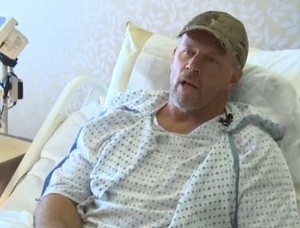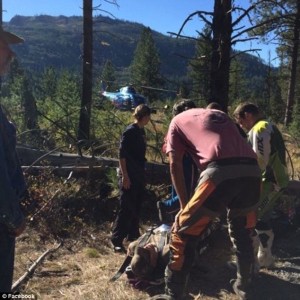
Posted on 11/23/2015 9:41:55 AM PST by w1n1

Before you read this story I would like to put emphasis on a couple of points. First and foremost, if you go hunting (especially in a remote area) always go with a partner. If something happens to you, the chances of getting out of trouble increase by having a buddy go with you. I would never go hunting alone, it's just too darn dangerous. Secondly, if you do hunt alone, always take a satellite phone, or a GPS locator with you. If you are hurt and cannot get back to civilization, at least you can let someone know exactly where you are. The man in this story was very lucky to have survived his ordeal.
 A hunter who crawled for days after breaking his leg in rugged central Idaho is recovering in a Boise hospital and says his love for his family gave him strength and prevented him from committing suicide. John Sain was tracking an elk alone in remote wilderness near McCall when his foot slipped between two logs and he fell.
A hunter who crawled for days after breaking his leg in rugged central Idaho is recovering in a Boise hospital and says his love for his family gave him strength and prevented him from committing suicide. John Sain was tracking an elk alone in remote wilderness near McCall when his foot slipped between two logs and he fell.
The accident broke both of the bones in Sain's lower leg, leaving him badly injured and unable to walk. 'I honestly didn't think I was going to make it out,' said Sain, a Darby, Montana, native who lives in Riverside, California. The 50-year-old was miles from the trail, didn't have cellphone service and was in a lot of pain. He briefly considered suicide, Sain said. Read the rest of the story here.
Good survival story, the human psyche is built in for self-survival.
He should have been thinking about his wife’s hooters for inspiration...
That was probably the last thing on his mind.
Backcountry by yourself is dangerous. As somebody that has to go looking for lost people, I can’t say enough about personal locator beacons. They take the search out of search and rescue. I have gone after several users of these devices and you fly to the point and look down, there’s the survivor. Even if you are lucky enough to be found right away by other hikers, you can save yourself so much time, by eliminating the need to be overdue, have somebody hike out to get help, and have searchers find you.
ping
Yikes.
Lesson, as the dude who had to cut off his own arm could have told him: Don’t go into the wilderness alone
Not just hunting. Fishing, hiking, etc. Always go with a partner and carry a locator beacon/sat. phone. I used to go out alone all the time. Never gave it a second thought until my father was badly injured on a solo fishing trip in the mountains. He was lucky to survive. As it was, he lost a leg. I never went out alone again. One little stupid slip and you're fighting for your life.
How do they work, do they send out an SOS signal that's picked up AFTER people realize you are lost and begin a search?
How much do they cost?
The Current FReepathon Pays For The Current Quarter's Expenses?

First and foremost, if you go hunting (especially in a remote area) always go with a partner.
And...
First and foremost, if you go to Chicago (especially in warm weather) always go with a 9MM or larger.
No satphone or GPS locator ever shot a buddy by mistake.
He was probably thinking “the wolves are coming, the wolves are coming”
I don't know, this is the first time I've heard of them.......
They start at around $300 and go up from there. Outfits like REAI, West Marine, Cabelas, etc. sell them. (not endorsing any of them)
Sorry, that should be REI...
The 406 beacons send the signal to a constellation of satellites which relay your distress signal to a national center. These are more expensive, but don't have associated subscription fees. The second type use commercial sat phone satellites. These are cheaper, but involve sat phone subscription fees. The most popular (maybe the only one) is SPOT. It basically sends sat phone text messages. You can send non-emergency position data that is forwarded through the Internet, or preprogrammed "l'm okay messages. When you hit emergency, SPOT will call your emergency contacts. If they can't get hold of them, they will call the Search and Rescuse agency for the county based upon your GPS location.
Both systems expect reception of your signal in 15 minutes or less.
The first guy I went looking for, that was using a SPOT, was solo hiking the Pacific Crest Trail. He slipped on the trail and rolled his ankle badly. The position provided by SPOT was exact. When we found him he was with a couple hikers that had stopped to help him. Using SPOT rather than having the hikers go for help saved this gentleman 15-18 hours in the wilderness.
I love McCall, Idaho and could see having a place there for SHTF.
Gorgeous area.
personal locator beacons.
How do they work, do they send out an SOS signal that's picked up AFTER people realize you are lost and begin a search?
----broadcasts a unique registered distress signal that not only tells rescuers where you are, but who you are. The onboard GPS can fix your position to within 100 meters and then utilizes a powerful 406 MHz signal to relay your distress call to orbiting satellites. As local Search and Rescue is deployed, a separate homing signal and integrated LED strobe light guide rescuers to your exact location.---- small enough to be easily carried in a pack or pocket or can be worn on deck, at the helm, in quarters or on a life vest and will float if accidentally dropped overboard. Performing a full functional self test of the PLB's internal circuitry, battery voltage & power, and 406 MHz transmission gives you the peace of mind knowing your PLB will work the moment you need it to the most. ACR Exclusive: Built-in GPS acquisition test mode allows you to test GPS functionality up to 12 times over the life of the battery life.
Distress radio beacons, also known as emergency beacons, PLB (Personal Locator Beacon), ELT (Emergency Locator Transmitter) or EPIRB (Emergency Position-Indicating Radio Beacon), are tracking transmitters which aid in the detection and location of boats, aircraft, and people in distress. Strictly, they are radiobeacons that interface with worldwide offered service of Cospas-Sarsat, the international satellite system for search and rescue (SAR). When manually activated, or automatically activated upon immersion, such beacons send out a distress signal. The signals are monitored worldwide and the location of the distress is detected by non-geostationary satellites, and can be located by some combination of GPS trilateration and doppler triangulation.
The basic purpose of a distress radiobeacon is to help rescuers find survivors within the so-called "golden day" (the first 24 hours following a traumatic event) during which the majority of survivors can usually be saved. Since the inception of Cospas-Sarsat in 1982, distress radiobeacons have assisted in the rescue of over 28,000 people in more than 7,000 distress situations. In 2010 alone, the system provided information which was used to rescue 2,388 persons in 641 distress situations.
Disclaimer: Opinions posted on Free Republic are those of the individual posters and do not necessarily represent the opinion of Free Republic or its management. All materials posted herein are protected by copyright law and the exemption for fair use of copyrighted works.